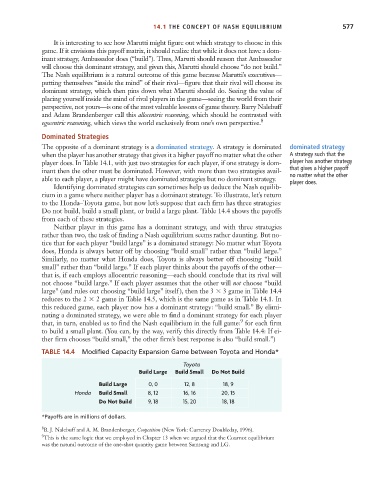Page 603 - Microeconomics, Fourth Edition
P. 603
c14gametheoryandstrategicbehavior.qxd 8/6/10 11:56 AM Page 577
14.1 THE CONCEPT OF NASH EQUILIBRIUM 577
It is interesting to see how Marutti might figure out which strategy to choose in this
game. If it envisions this payoff matrix, it should realize that while it does not have a dom-
inant strategy, Ambassador does (“build”). Thus, Marutti should reason that Ambassador
will choose this dominant strategy, and given this, Marutti should choose “do not build.”
The Nash equilibrium is a natural outcome of this game because Marutti’s executives—
putting themselves “inside the mind” of their rival—figure that their rival will choose its
dominant strategy, which then pins down what Marutti should do. Seeing the value of
placing yourself inside the mind of rival players in the game—seeing the world from their
perspective, not yours—is one of the most valuable lessons of game theory. Barry Nalebuff
and Adam Brandenberger call this allocentric reasoning, which should be contrasted with
egocentric reasoning, which views the world exclusively from one’s own perspective. 8
Dominated Strategies
The opposite of a dominant strategy is a dominated strategy. A strategy is dominated dominated strategy
when the player has another strategy that gives it a higher payoff no matter what the other A strategy such that the
player does. In Table 14.1, with just two strategies for each player, if one strategy is dom- player has another strategy
inant then the other must be dominated. However, with more than two strategies avail- that gives a higher payoff
able to each player, a player might have dominated strategies but no dominant strategy. no matter what the other
player does.
Identifying dominated strategies can sometimes help us deduce the Nash equilib-
rium in a game where neither player has a dominant strategy. To illustrate, let’s return
to the Honda–Toyota game, but now let’s suppose that each firm has three strategies:
Do not build, build a small plant, or build a large plant. Table 14.4 shows the payoffs
from each of these strategies.
Neither player in this game has a dominant strategy, and with three strategies
rather than two, the task of finding a Nash equilibrium seems rather daunting. But no-
tice that for each player “build large” is a dominated strategy: No matter what Toyota
does, Honda is always better off by choosing “build small” rather than “build large.”
Similarly, no matter what Honda does, Toyota is always better off choosing “build
small” rather than “build large.” If each player thinks about the payoffs of the other—
that is, if each employs allocentric reasoning—each should conclude that its rival will
not choose “build large.” If each player assumes that the other will not choose “build
large” (and rules out choosing “build large” itself ), then the 3 3 game in Table 14.4
reduces to the 2 2 game in Table 14.5, which is the same game as in Table 14.1. In
this reduced game, each player now has a dominant strategy: “build small.” By elimi-
nating a dominated strategy, we were able to find a dominant strategy for each player
9
that, in turn, enabled us to find the Nash equilibrium in the full game: for each firm
to build a small plant. (You can, by the way, verify this directly from Table 14.4: If ei-
ther firm chooses “build small,” the other firm’s best response is also “build small.”)
TABLE 14.4 Modified Capacity Expansion Game between Toyota and Honda*
Toyota
Build Large Build Small Do Not Build
Build Large 0, 0 12, 8 18, 9
Honda Build Small 8, 12 16, 16 20, 15
Do Not Build 9, 18 15, 20 18, 18
*Payoffs are in millions of dollars.
8 B. J. Nalebuff and A. M. Brandenberger, Coopetition (New York: Currency Doubleday, 1996).
9 This is the same logic that we employed in Chapter 13 when we argued that the Cournot equilibrium
was the natural outcome of the one-shot quantity game between Samsung and LG.

